Independent Critical Analysis Project 2019: Eggshellent Cafe Menu
VerifiedAdded on 2023/03/21
|24
|6434
|99
Report
AI Summary
This independent critical analysis project examines Eggshellent cafe's menu attributes and their impact on customer satisfaction and revenue. The report investigates the cafe's menu changes, which involved removing unpopular dishes and increasing prices, and the resulting decline in customer satisfaction and revenue. The research methodology included a literature review, face-to-face interviews, audio recordings, and semi-structured questionnaires to gather data. The findings reveal issues with menu design, lack of dish signature, food quality, and pricing. The report also explores menu definitions, the history of menus, and different menu taxonomies. The paper concludes with recommendations for improving the menu to increase customer satisfaction and revive the cafe's success, emphasizing the importance of menu development and marketing as a competitive advantage in the hospitality industry. The report aims to answer the research question: How can Eggshellent cafe restaurant increase customer satisfaction by upgrading the menu attributes?
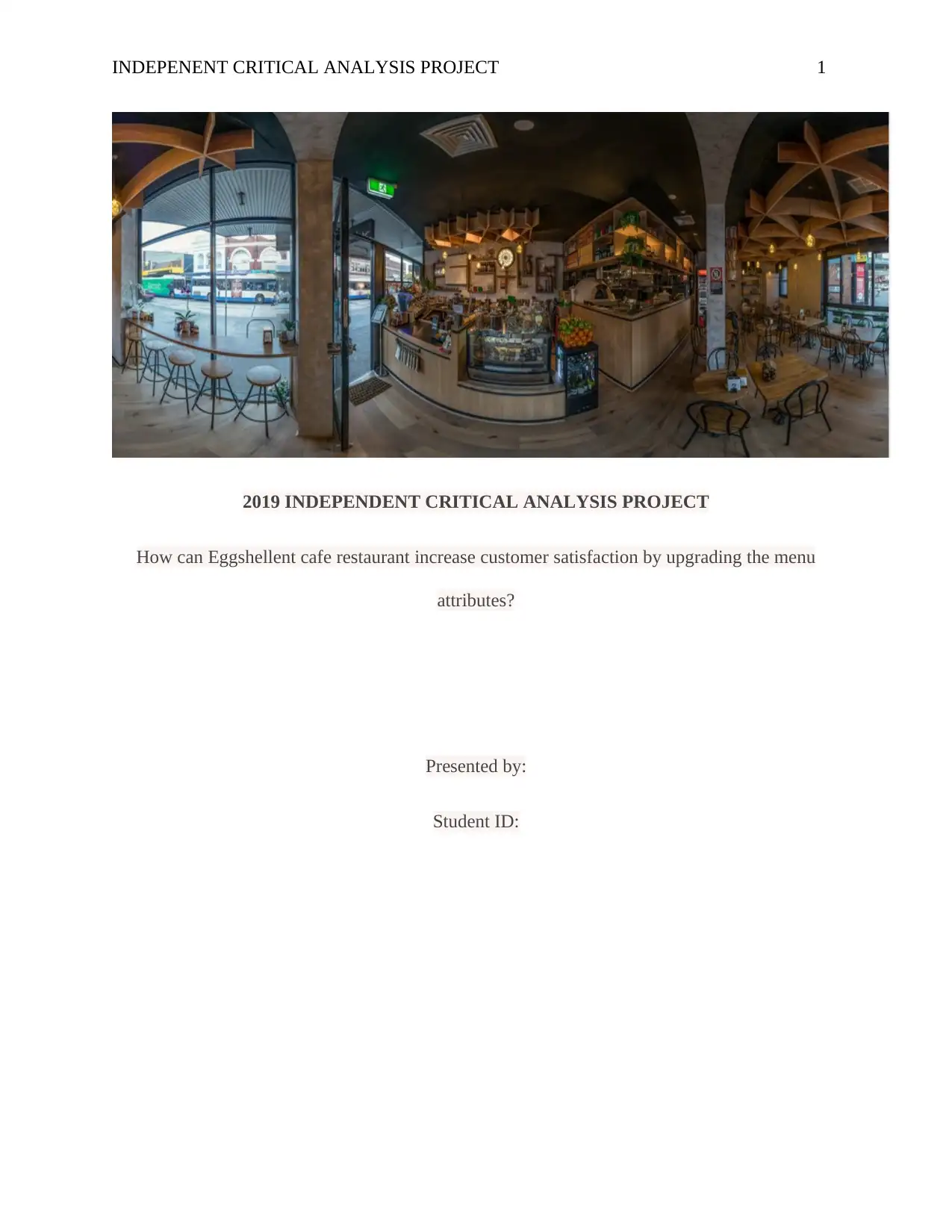
INDEPENENT CRITICAL ANALYSIS PROJECT 1
2019 INDEPENDENT CRITICAL ANALYSIS PROJECT
How can Eggshellent cafe restaurant increase customer satisfaction by upgrading the menu
attributes?
Presented by:
Student ID:
2019 INDEPENDENT CRITICAL ANALYSIS PROJECT
How can Eggshellent cafe restaurant increase customer satisfaction by upgrading the menu
attributes?
Presented by:
Student ID:
Paraphrase This Document
Need a fresh take? Get an instant paraphrase of this document with our AI Paraphraser
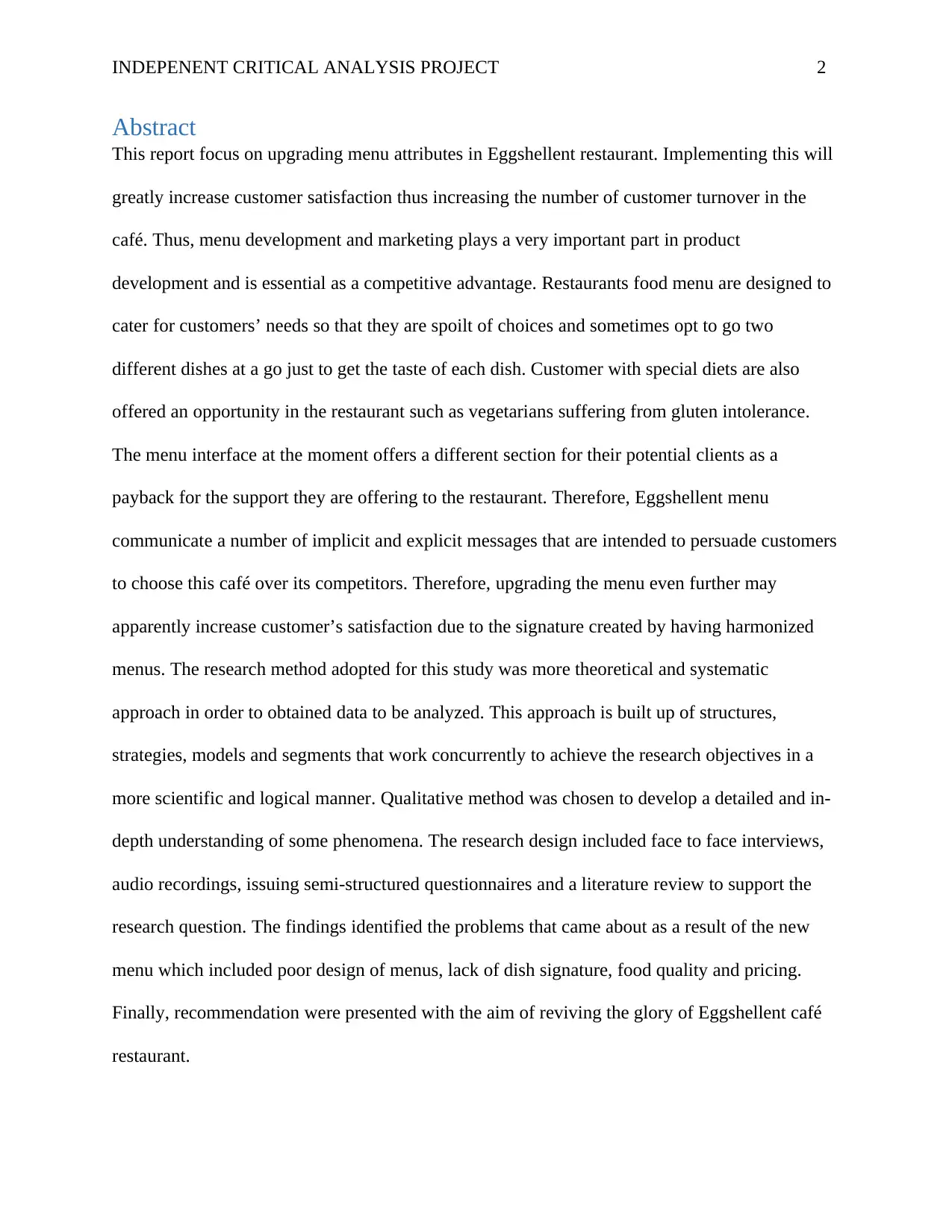
INDEPENENT CRITICAL ANALYSIS PROJECT 2
Abstract
This report focus on upgrading menu attributes in Eggshellent restaurant. Implementing this will
greatly increase customer satisfaction thus increasing the number of customer turnover in the
café. Thus, menu development and marketing plays a very important part in product
development and is essential as a competitive advantage. Restaurants food menu are designed to
cater for customers’ needs so that they are spoilt of choices and sometimes opt to go two
different dishes at a go just to get the taste of each dish. Customer with special diets are also
offered an opportunity in the restaurant such as vegetarians suffering from gluten intolerance.
The menu interface at the moment offers a different section for their potential clients as a
payback for the support they are offering to the restaurant. Therefore, Eggshellent menu
communicate a number of implicit and explicit messages that are intended to persuade customers
to choose this café over its competitors. Therefore, upgrading the menu even further may
apparently increase customer’s satisfaction due to the signature created by having harmonized
menus. The research method adopted for this study was more theoretical and systematic
approach in order to obtained data to be analyzed. This approach is built up of structures,
strategies, models and segments that work concurrently to achieve the research objectives in a
more scientific and logical manner. Qualitative method was chosen to develop a detailed and in-
depth understanding of some phenomena. The research design included face to face interviews,
audio recordings, issuing semi-structured questionnaires and a literature review to support the
research question. The findings identified the problems that came about as a result of the new
menu which included poor design of menus, lack of dish signature, food quality and pricing.
Finally, recommendation were presented with the aim of reviving the glory of Eggshellent café
restaurant.
Abstract
This report focus on upgrading menu attributes in Eggshellent restaurant. Implementing this will
greatly increase customer satisfaction thus increasing the number of customer turnover in the
café. Thus, menu development and marketing plays a very important part in product
development and is essential as a competitive advantage. Restaurants food menu are designed to
cater for customers’ needs so that they are spoilt of choices and sometimes opt to go two
different dishes at a go just to get the taste of each dish. Customer with special diets are also
offered an opportunity in the restaurant such as vegetarians suffering from gluten intolerance.
The menu interface at the moment offers a different section for their potential clients as a
payback for the support they are offering to the restaurant. Therefore, Eggshellent menu
communicate a number of implicit and explicit messages that are intended to persuade customers
to choose this café over its competitors. Therefore, upgrading the menu even further may
apparently increase customer’s satisfaction due to the signature created by having harmonized
menus. The research method adopted for this study was more theoretical and systematic
approach in order to obtained data to be analyzed. This approach is built up of structures,
strategies, models and segments that work concurrently to achieve the research objectives in a
more scientific and logical manner. Qualitative method was chosen to develop a detailed and in-
depth understanding of some phenomena. The research design included face to face interviews,
audio recordings, issuing semi-structured questionnaires and a literature review to support the
research question. The findings identified the problems that came about as a result of the new
menu which included poor design of menus, lack of dish signature, food quality and pricing.
Finally, recommendation were presented with the aim of reviving the glory of Eggshellent café
restaurant.
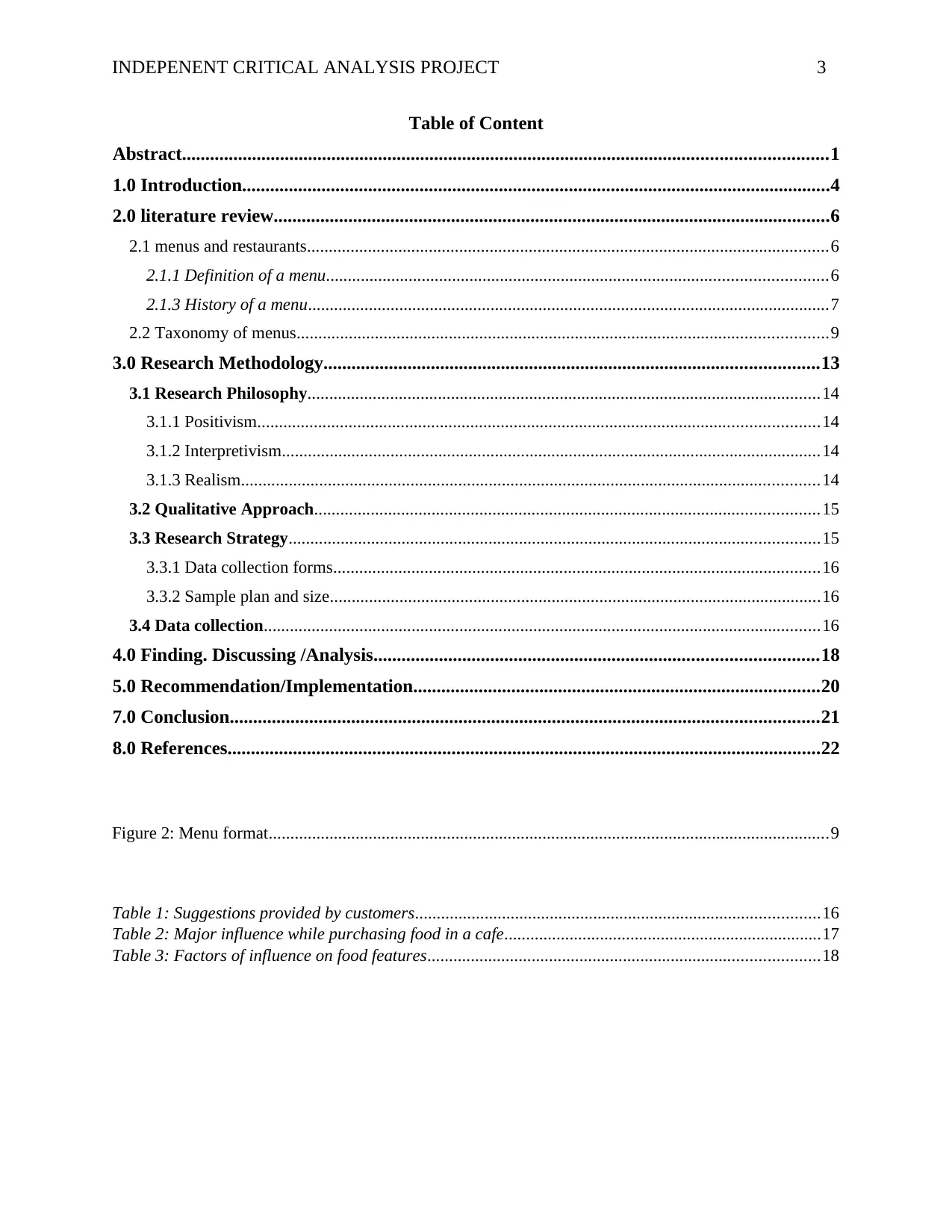
INDEPENENT CRITICAL ANALYSIS PROJECT 3
Table of Content
Abstract..........................................................................................................................................1
1.0 Introduction..............................................................................................................................4
2.0 literature review.......................................................................................................................6
2.1 menus and restaurants........................................................................................................................6
2.1.1 Definition of a menu...................................................................................................................6
2.1.3 History of a menu........................................................................................................................7
2.2 Taxonomy of menus..........................................................................................................................9
3.0 Research Methodology..........................................................................................................13
3.1 Research Philosophy......................................................................................................................14
3.1.1 Positivism.................................................................................................................................14
3.1.2 Interpretivism............................................................................................................................14
3.1.3 Realism.....................................................................................................................................14
3.2 Qualitative Approach....................................................................................................................15
3.3 Research Strategy..........................................................................................................................15
3.3.1 Data collection forms................................................................................................................16
3.3.2 Sample plan and size.................................................................................................................16
3.4 Data collection................................................................................................................................16
4.0 Finding. Discussing /Analysis...............................................................................................18
5.0 Recommendation/Implementation.......................................................................................20
7.0 Conclusion..............................................................................................................................21
8.0 References...............................................................................................................................22
Figure 2: Menu format.................................................................................................................................9
Table 1: Suggestions provided by customers.............................................................................................16
Table 2: Major influence while purchasing food in a cafe.........................................................................17
Table 3: Factors of influence on food features..........................................................................................18
Table of Content
Abstract..........................................................................................................................................1
1.0 Introduction..............................................................................................................................4
2.0 literature review.......................................................................................................................6
2.1 menus and restaurants........................................................................................................................6
2.1.1 Definition of a menu...................................................................................................................6
2.1.3 History of a menu........................................................................................................................7
2.2 Taxonomy of menus..........................................................................................................................9
3.0 Research Methodology..........................................................................................................13
3.1 Research Philosophy......................................................................................................................14
3.1.1 Positivism.................................................................................................................................14
3.1.2 Interpretivism............................................................................................................................14
3.1.3 Realism.....................................................................................................................................14
3.2 Qualitative Approach....................................................................................................................15
3.3 Research Strategy..........................................................................................................................15
3.3.1 Data collection forms................................................................................................................16
3.3.2 Sample plan and size.................................................................................................................16
3.4 Data collection................................................................................................................................16
4.0 Finding. Discussing /Analysis...............................................................................................18
5.0 Recommendation/Implementation.......................................................................................20
7.0 Conclusion..............................................................................................................................21
8.0 References...............................................................................................................................22
Figure 2: Menu format.................................................................................................................................9
Table 1: Suggestions provided by customers.............................................................................................16
Table 2: Major influence while purchasing food in a cafe.........................................................................17
Table 3: Factors of influence on food features..........................................................................................18
⊘ This is a preview!⊘
Do you want full access?
Subscribe today to unlock all pages.

Trusted by 1+ million students worldwide
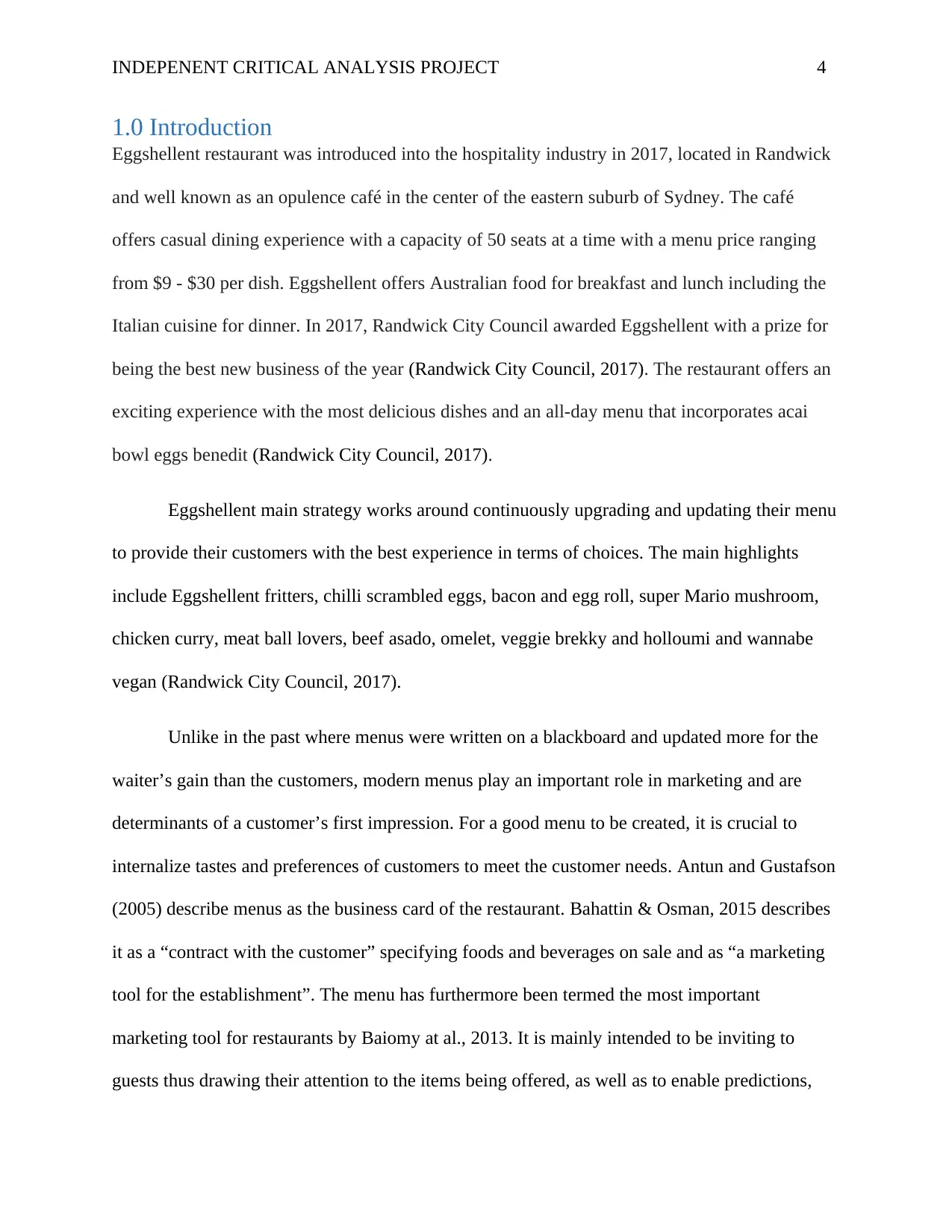
INDEPENENT CRITICAL ANALYSIS PROJECT 4
1.0 Introduction
Eggshellent restaurant was introduced into the hospitality industry in 2017, located in Randwick
and well known as an opulence café in the center of the eastern suburb of Sydney. The café
offers casual dining experience with a capacity of 50 seats at a time with a menu price ranging
from $9 - $30 per dish. Eggshellent offers Australian food for breakfast and lunch including the
Italian cuisine for dinner. In 2017, Randwick City Council awarded Eggshellent with a prize for
being the best new business of the year (Randwick City Council, 2017). The restaurant offers an
exciting experience with the most delicious dishes and an all-day menu that incorporates acai
bowl eggs benedit (Randwick City Council, 2017).
Eggshellent main strategy works around continuously upgrading and updating their menu
to provide their customers with the best experience in terms of choices. The main highlights
include Eggshellent fritters, chilli scrambled eggs, bacon and egg roll, super Mario mushroom,
chicken curry, meat ball lovers, beef asado, omelet, veggie brekky and holloumi and wannabe
vegan (Randwick City Council, 2017).
Unlike in the past where menus were written on a blackboard and updated more for the
waiter’s gain than the customers, modern menus play an important role in marketing and are
determinants of a customer’s first impression. For a good menu to be created, it is crucial to
internalize tastes and preferences of customers to meet the customer needs. Antun and Gustafson
(2005) describe menus as the business card of the restaurant. Bahattin & Osman, 2015 describes
it as a “contract with the customer” specifying foods and beverages on sale and as “a marketing
tool for the establishment”. The menu has furthermore been termed the most important
marketing tool for restaurants by Baiomy at al., 2013. It is mainly intended to be inviting to
guests thus drawing their attention to the items being offered, as well as to enable predictions,
1.0 Introduction
Eggshellent restaurant was introduced into the hospitality industry in 2017, located in Randwick
and well known as an opulence café in the center of the eastern suburb of Sydney. The café
offers casual dining experience with a capacity of 50 seats at a time with a menu price ranging
from $9 - $30 per dish. Eggshellent offers Australian food for breakfast and lunch including the
Italian cuisine for dinner. In 2017, Randwick City Council awarded Eggshellent with a prize for
being the best new business of the year (Randwick City Council, 2017). The restaurant offers an
exciting experience with the most delicious dishes and an all-day menu that incorporates acai
bowl eggs benedit (Randwick City Council, 2017).
Eggshellent main strategy works around continuously upgrading and updating their menu
to provide their customers with the best experience in terms of choices. The main highlights
include Eggshellent fritters, chilli scrambled eggs, bacon and egg roll, super Mario mushroom,
chicken curry, meat ball lovers, beef asado, omelet, veggie brekky and holloumi and wannabe
vegan (Randwick City Council, 2017).
Unlike in the past where menus were written on a blackboard and updated more for the
waiter’s gain than the customers, modern menus play an important role in marketing and are
determinants of a customer’s first impression. For a good menu to be created, it is crucial to
internalize tastes and preferences of customers to meet the customer needs. Antun and Gustafson
(2005) describe menus as the business card of the restaurant. Bahattin & Osman, 2015 describes
it as a “contract with the customer” specifying foods and beverages on sale and as “a marketing
tool for the establishment”. The menu has furthermore been termed the most important
marketing tool for restaurants by Baiomy at al., 2013. It is mainly intended to be inviting to
guests thus drawing their attention to the items being offered, as well as to enable predictions,
Paraphrase This Document
Need a fresh take? Get an instant paraphrase of this document with our AI Paraphraser
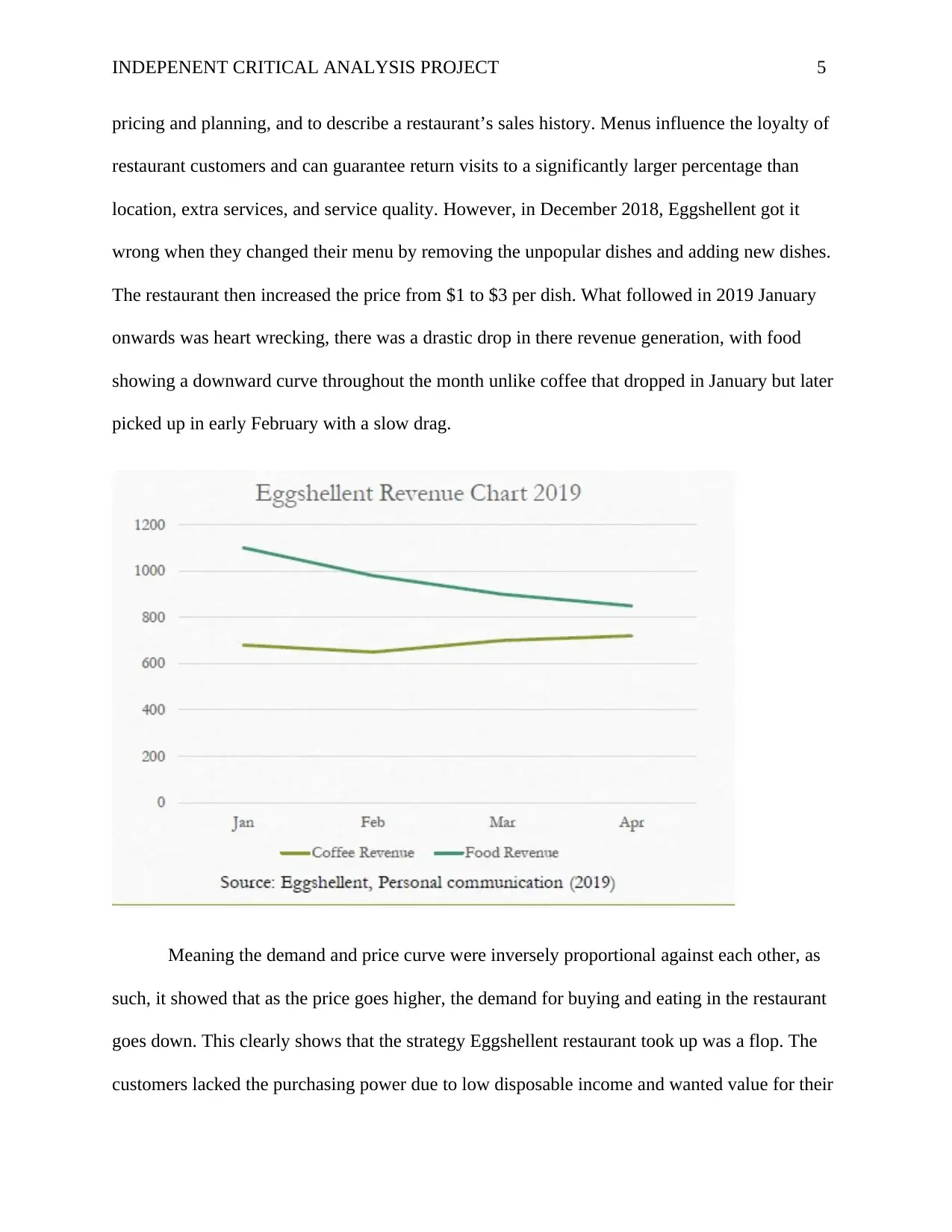
INDEPENENT CRITICAL ANALYSIS PROJECT 5
pricing and planning, and to describe a restaurant’s sales history. Menus influence the loyalty of
restaurant customers and can guarantee return visits to a significantly larger percentage than
location, extra services, and service quality. However, in December 2018, Eggshellent got it
wrong when they changed their menu by removing the unpopular dishes and adding new dishes.
The restaurant then increased the price from $1 to $3 per dish. What followed in 2019 January
onwards was heart wrecking, there was a drastic drop in there revenue generation, with food
showing a downward curve throughout the month unlike coffee that dropped in January but later
picked up in early February with a slow drag.
Meaning the demand and price curve were inversely proportional against each other, as
such, it showed that as the price goes higher, the demand for buying and eating in the restaurant
goes down. This clearly shows that the strategy Eggshellent restaurant took up was a flop. The
customers lacked the purchasing power due to low disposable income and wanted value for their
pricing and planning, and to describe a restaurant’s sales history. Menus influence the loyalty of
restaurant customers and can guarantee return visits to a significantly larger percentage than
location, extra services, and service quality. However, in December 2018, Eggshellent got it
wrong when they changed their menu by removing the unpopular dishes and adding new dishes.
The restaurant then increased the price from $1 to $3 per dish. What followed in 2019 January
onwards was heart wrecking, there was a drastic drop in there revenue generation, with food
showing a downward curve throughout the month unlike coffee that dropped in January but later
picked up in early February with a slow drag.
Meaning the demand and price curve were inversely proportional against each other, as
such, it showed that as the price goes higher, the demand for buying and eating in the restaurant
goes down. This clearly shows that the strategy Eggshellent restaurant took up was a flop. The
customers lacked the purchasing power due to low disposable income and wanted value for their
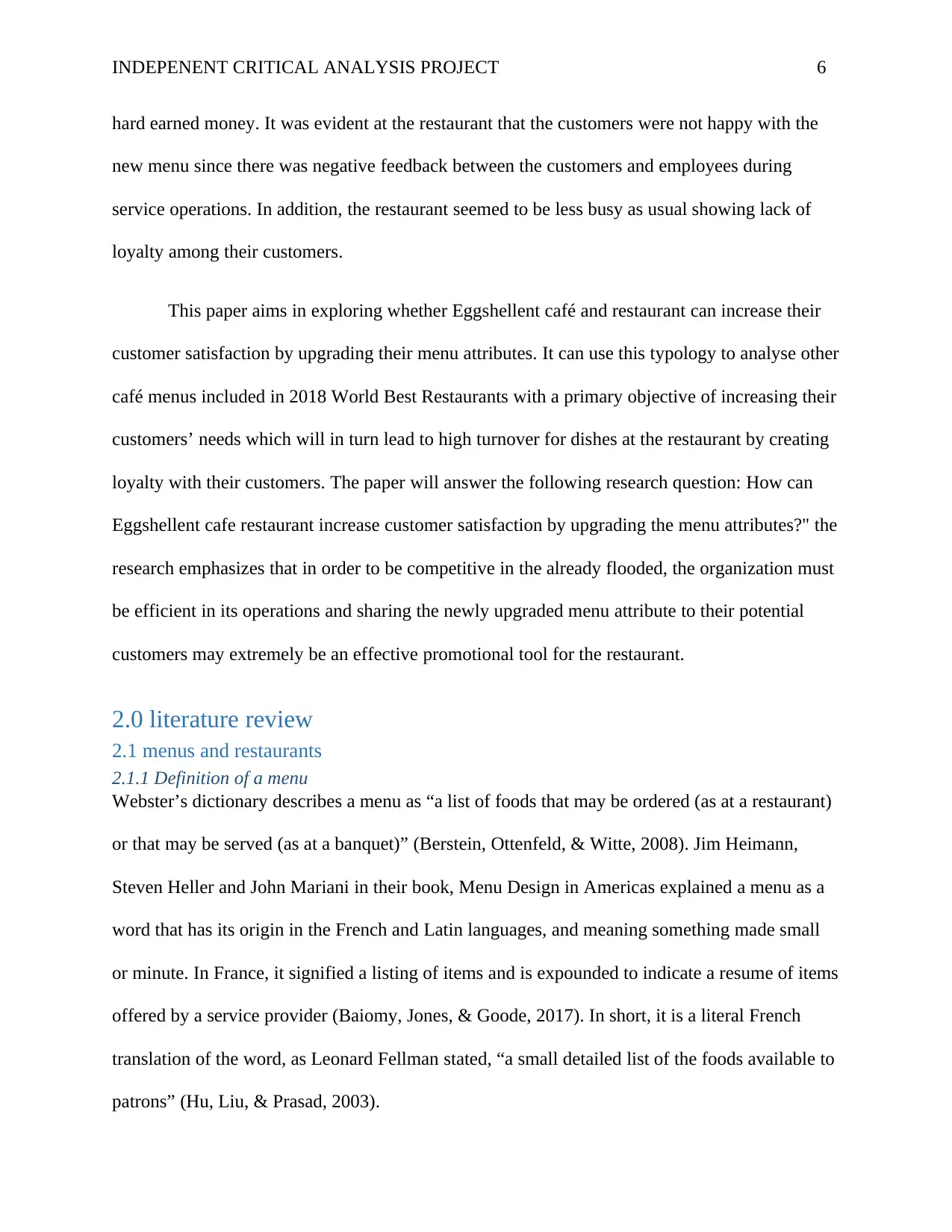
INDEPENENT CRITICAL ANALYSIS PROJECT 6
hard earned money. It was evident at the restaurant that the customers were not happy with the
new menu since there was negative feedback between the customers and employees during
service operations. In addition, the restaurant seemed to be less busy as usual showing lack of
loyalty among their customers.
This paper aims in exploring whether Eggshellent café and restaurant can increase their
customer satisfaction by upgrading their menu attributes. It can use this typology to analyse other
café menus included in 2018 World Best Restaurants with a primary objective of increasing their
customers’ needs which will in turn lead to high turnover for dishes at the restaurant by creating
loyalty with their customers. The paper will answer the following research question: How can
Eggshellent cafe restaurant increase customer satisfaction by upgrading the menu attributes?" the
research emphasizes that in order to be competitive in the already flooded, the organization must
be efficient in its operations and sharing the newly upgraded menu attribute to their potential
customers may extremely be an effective promotional tool for the restaurant.
2.0 literature review
2.1 menus and restaurants
2.1.1 Definition of a menu
Webster’s dictionary describes a menu as “a list of foods that may be ordered (as at a restaurant)
or that may be served (as at a banquet)” (Berstein, Ottenfeld, & Witte, 2008). Jim Heimann,
Steven Heller and John Mariani in their book, Menu Design in Americas explained a menu as a
word that has its origin in the French and Latin languages, and meaning something made small
or minute. In France, it signified a listing of items and is expounded to indicate a resume of items
offered by a service provider (Baiomy, Jones, & Goode, 2017). In short, it is a literal French
translation of the word, as Leonard Fellman stated, “a small detailed list of the foods available to
patrons” (Hu, Liu, & Prasad, 2003).
hard earned money. It was evident at the restaurant that the customers were not happy with the
new menu since there was negative feedback between the customers and employees during
service operations. In addition, the restaurant seemed to be less busy as usual showing lack of
loyalty among their customers.
This paper aims in exploring whether Eggshellent café and restaurant can increase their
customer satisfaction by upgrading their menu attributes. It can use this typology to analyse other
café menus included in 2018 World Best Restaurants with a primary objective of increasing their
customers’ needs which will in turn lead to high turnover for dishes at the restaurant by creating
loyalty with their customers. The paper will answer the following research question: How can
Eggshellent cafe restaurant increase customer satisfaction by upgrading the menu attributes?" the
research emphasizes that in order to be competitive in the already flooded, the organization must
be efficient in its operations and sharing the newly upgraded menu attribute to their potential
customers may extremely be an effective promotional tool for the restaurant.
2.0 literature review
2.1 menus and restaurants
2.1.1 Definition of a menu
Webster’s dictionary describes a menu as “a list of foods that may be ordered (as at a restaurant)
or that may be served (as at a banquet)” (Berstein, Ottenfeld, & Witte, 2008). Jim Heimann,
Steven Heller and John Mariani in their book, Menu Design in Americas explained a menu as a
word that has its origin in the French and Latin languages, and meaning something made small
or minute. In France, it signified a listing of items and is expounded to indicate a resume of items
offered by a service provider (Baiomy, Jones, & Goode, 2017). In short, it is a literal French
translation of the word, as Leonard Fellman stated, “a small detailed list of the foods available to
patrons” (Hu, Liu, & Prasad, 2003).
⊘ This is a preview!⊘
Do you want full access?
Subscribe today to unlock all pages.

Trusted by 1+ million students worldwide
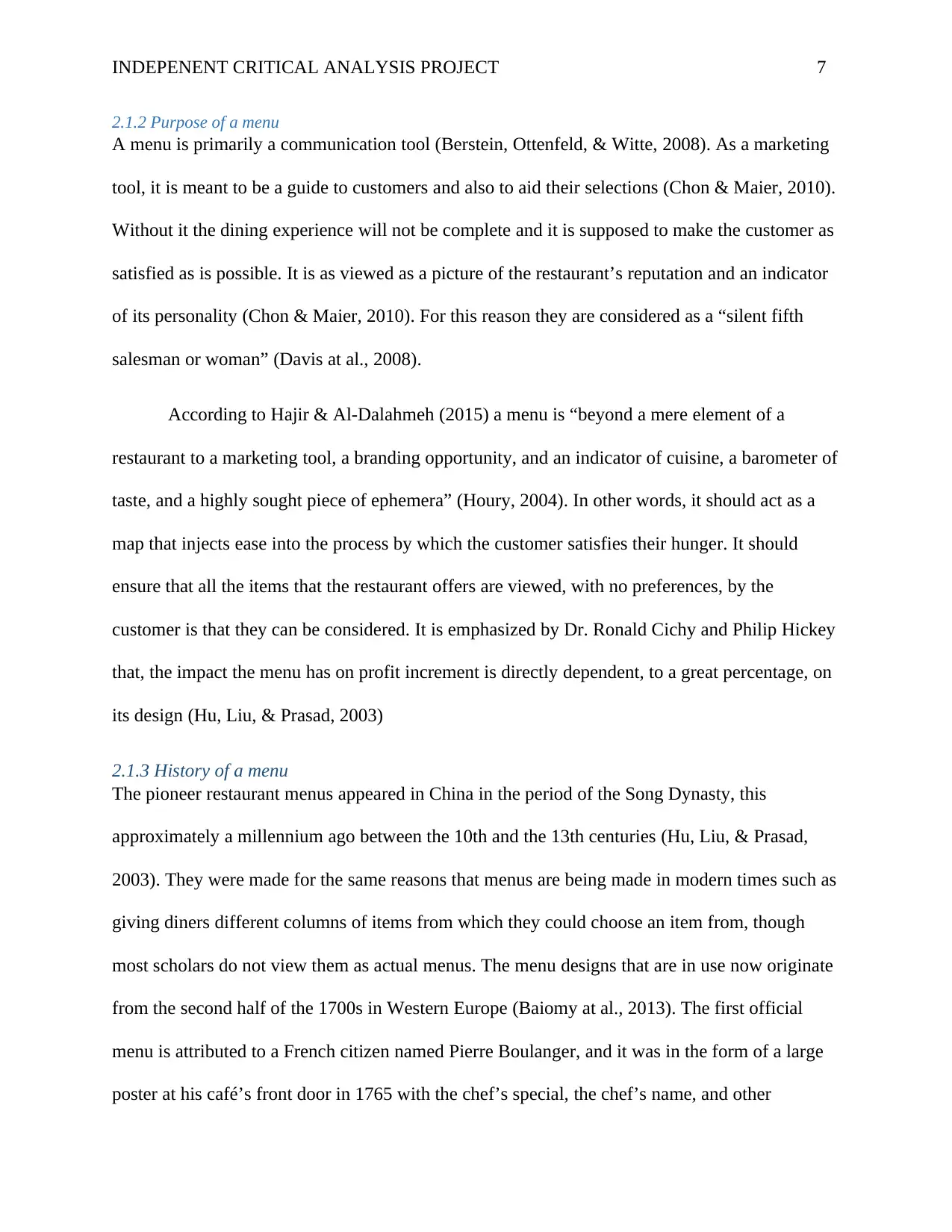
INDEPENENT CRITICAL ANALYSIS PROJECT 7
2.1.2 Purpose of a menu
A menu is primarily a communication tool (Berstein, Ottenfeld, & Witte, 2008). As a marketing
tool, it is meant to be a guide to customers and also to aid their selections (Chon & Maier, 2010).
Without it the dining experience will not be complete and it is supposed to make the customer as
satisfied as is possible. It is as viewed as a picture of the restaurant’s reputation and an indicator
of its personality (Chon & Maier, 2010). For this reason they are considered as a “silent fifth
salesman or woman” (Davis at al., 2008).
According to Hajir & Al-Dalahmeh (2015) a menu is “beyond a mere element of a
restaurant to a marketing tool, a branding opportunity, and an indicator of cuisine, a barometer of
taste, and a highly sought piece of ephemera” (Houry, 2004). In other words, it should act as a
map that injects ease into the process by which the customer satisfies their hunger. It should
ensure that all the items that the restaurant offers are viewed, with no preferences, by the
customer is that they can be considered. It is emphasized by Dr. Ronald Cichy and Philip Hickey
that, the impact the menu has on profit increment is directly dependent, to a great percentage, on
its design (Hu, Liu, & Prasad, 2003)
2.1.3 History of a menu
The pioneer restaurant menus appeared in China in the period of the Song Dynasty, this
approximately a millennium ago between the 10th and the 13th centuries (Hu, Liu, & Prasad,
2003). They were made for the same reasons that menus are being made in modern times such as
giving diners different columns of items from which they could choose an item from, though
most scholars do not view them as actual menus. The menu designs that are in use now originate
from the second half of the 1700s in Western Europe (Baiomy at al., 2013). The first official
menu is attributed to a French citizen named Pierre Boulanger, and it was in the form of a large
poster at his café’s front door in 1765 with the chef’s special, the chef’s name, and other
2.1.2 Purpose of a menu
A menu is primarily a communication tool (Berstein, Ottenfeld, & Witte, 2008). As a marketing
tool, it is meant to be a guide to customers and also to aid their selections (Chon & Maier, 2010).
Without it the dining experience will not be complete and it is supposed to make the customer as
satisfied as is possible. It is as viewed as a picture of the restaurant’s reputation and an indicator
of its personality (Chon & Maier, 2010). For this reason they are considered as a “silent fifth
salesman or woman” (Davis at al., 2008).
According to Hajir & Al-Dalahmeh (2015) a menu is “beyond a mere element of a
restaurant to a marketing tool, a branding opportunity, and an indicator of cuisine, a barometer of
taste, and a highly sought piece of ephemera” (Houry, 2004). In other words, it should act as a
map that injects ease into the process by which the customer satisfies their hunger. It should
ensure that all the items that the restaurant offers are viewed, with no preferences, by the
customer is that they can be considered. It is emphasized by Dr. Ronald Cichy and Philip Hickey
that, the impact the menu has on profit increment is directly dependent, to a great percentage, on
its design (Hu, Liu, & Prasad, 2003)
2.1.3 History of a menu
The pioneer restaurant menus appeared in China in the period of the Song Dynasty, this
approximately a millennium ago between the 10th and the 13th centuries (Hu, Liu, & Prasad,
2003). They were made for the same reasons that menus are being made in modern times such as
giving diners different columns of items from which they could choose an item from, though
most scholars do not view them as actual menus. The menu designs that are in use now originate
from the second half of the 1700s in Western Europe (Baiomy at al., 2013). The first official
menu is attributed to a French citizen named Pierre Boulanger, and it was in the form of a large
poster at his café’s front door in 1765 with the chef’s special, the chef’s name, and other
Paraphrase This Document
Need a fresh take? Get an instant paraphrase of this document with our AI Paraphraser
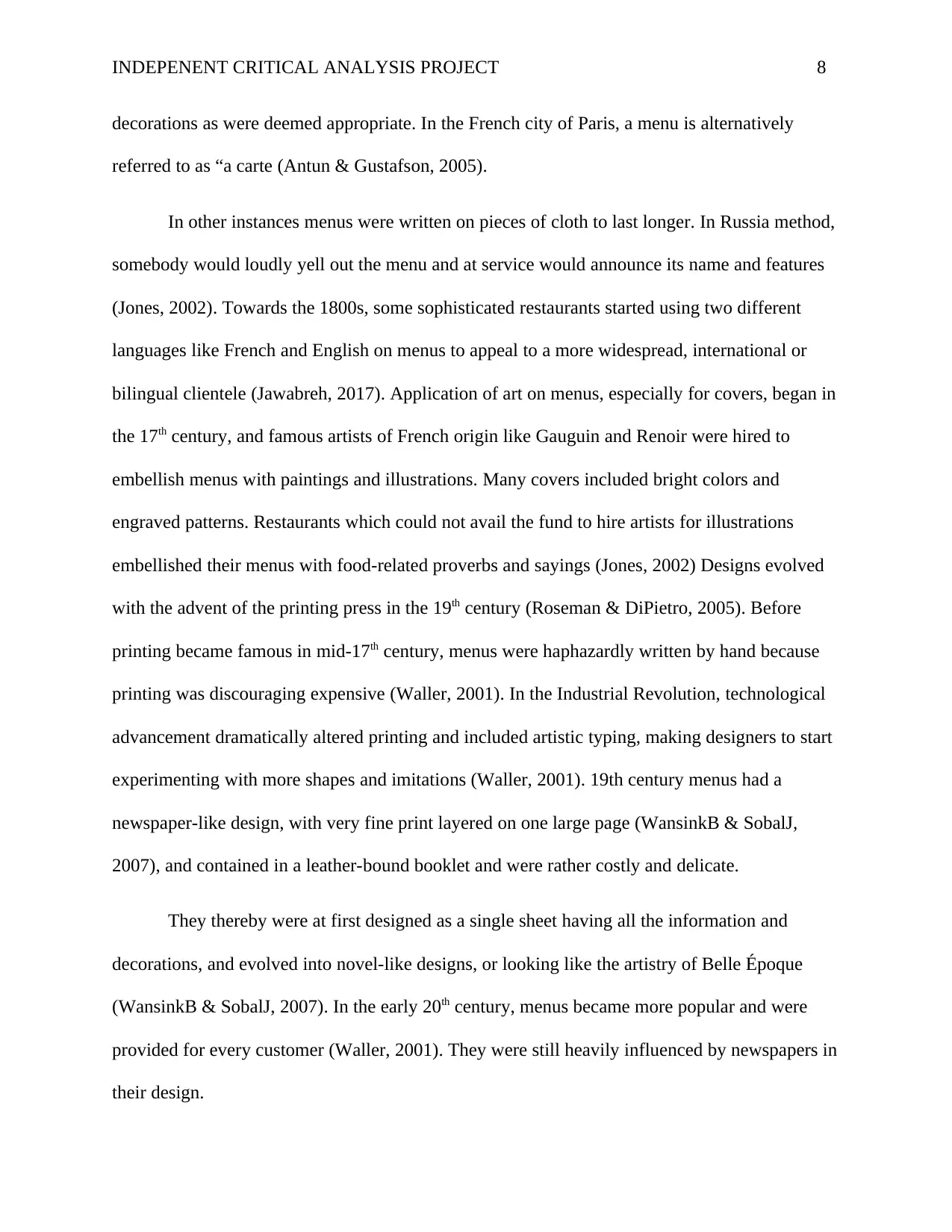
INDEPENENT CRITICAL ANALYSIS PROJECT 8
decorations as were deemed appropriate. In the French city of Paris, a menu is alternatively
referred to as “a carte (Antun & Gustafson, 2005).
In other instances menus were written on pieces of cloth to last longer. In Russia method,
somebody would loudly yell out the menu and at service would announce its name and features
(Jones, 2002). Towards the 1800s, some sophisticated restaurants started using two different
languages like French and English on menus to appeal to a more widespread, international or
bilingual clientele (Jawabreh, 2017). Application of art on menus, especially for covers, began in
the 17th century, and famous artists of French origin like Gauguin and Renoir were hired to
embellish menus with paintings and illustrations. Many covers included bright colors and
engraved patterns. Restaurants which could not avail the fund to hire artists for illustrations
embellished their menus with food-related proverbs and sayings (Jones, 2002) Designs evolved
with the advent of the printing press in the 19th century (Roseman & DiPietro, 2005). Before
printing became famous in mid-17th century, menus were haphazardly written by hand because
printing was discouraging expensive (Waller, 2001). In the Industrial Revolution, technological
advancement dramatically altered printing and included artistic typing, making designers to start
experimenting with more shapes and imitations (Waller, 2001). 19th century menus had a
newspaper-like design, with very fine print layered on one large page (WansinkB & SobalJ,
2007), and contained in a leather-bound booklet and were rather costly and delicate.
They thereby were at first designed as a single sheet having all the information and
decorations, and evolved into novel-like designs, or looking like the artistry of Belle Époque
(WansinkB & SobalJ, 2007). In the early 20th century, menus became more popular and were
provided for every customer (Waller, 2001). They were still heavily influenced by newspapers in
their design.
decorations as were deemed appropriate. In the French city of Paris, a menu is alternatively
referred to as “a carte (Antun & Gustafson, 2005).
In other instances menus were written on pieces of cloth to last longer. In Russia method,
somebody would loudly yell out the menu and at service would announce its name and features
(Jones, 2002). Towards the 1800s, some sophisticated restaurants started using two different
languages like French and English on menus to appeal to a more widespread, international or
bilingual clientele (Jawabreh, 2017). Application of art on menus, especially for covers, began in
the 17th century, and famous artists of French origin like Gauguin and Renoir were hired to
embellish menus with paintings and illustrations. Many covers included bright colors and
engraved patterns. Restaurants which could not avail the fund to hire artists for illustrations
embellished their menus with food-related proverbs and sayings (Jones, 2002) Designs evolved
with the advent of the printing press in the 19th century (Roseman & DiPietro, 2005). Before
printing became famous in mid-17th century, menus were haphazardly written by hand because
printing was discouraging expensive (Waller, 2001). In the Industrial Revolution, technological
advancement dramatically altered printing and included artistic typing, making designers to start
experimenting with more shapes and imitations (Waller, 2001). 19th century menus had a
newspaper-like design, with very fine print layered on one large page (WansinkB & SobalJ,
2007), and contained in a leather-bound booklet and were rather costly and delicate.
They thereby were at first designed as a single sheet having all the information and
decorations, and evolved into novel-like designs, or looking like the artistry of Belle Époque
(WansinkB & SobalJ, 2007). In the early 20th century, menus became more popular and were
provided for every customer (Waller, 2001). They were still heavily influenced by newspapers in
their design.
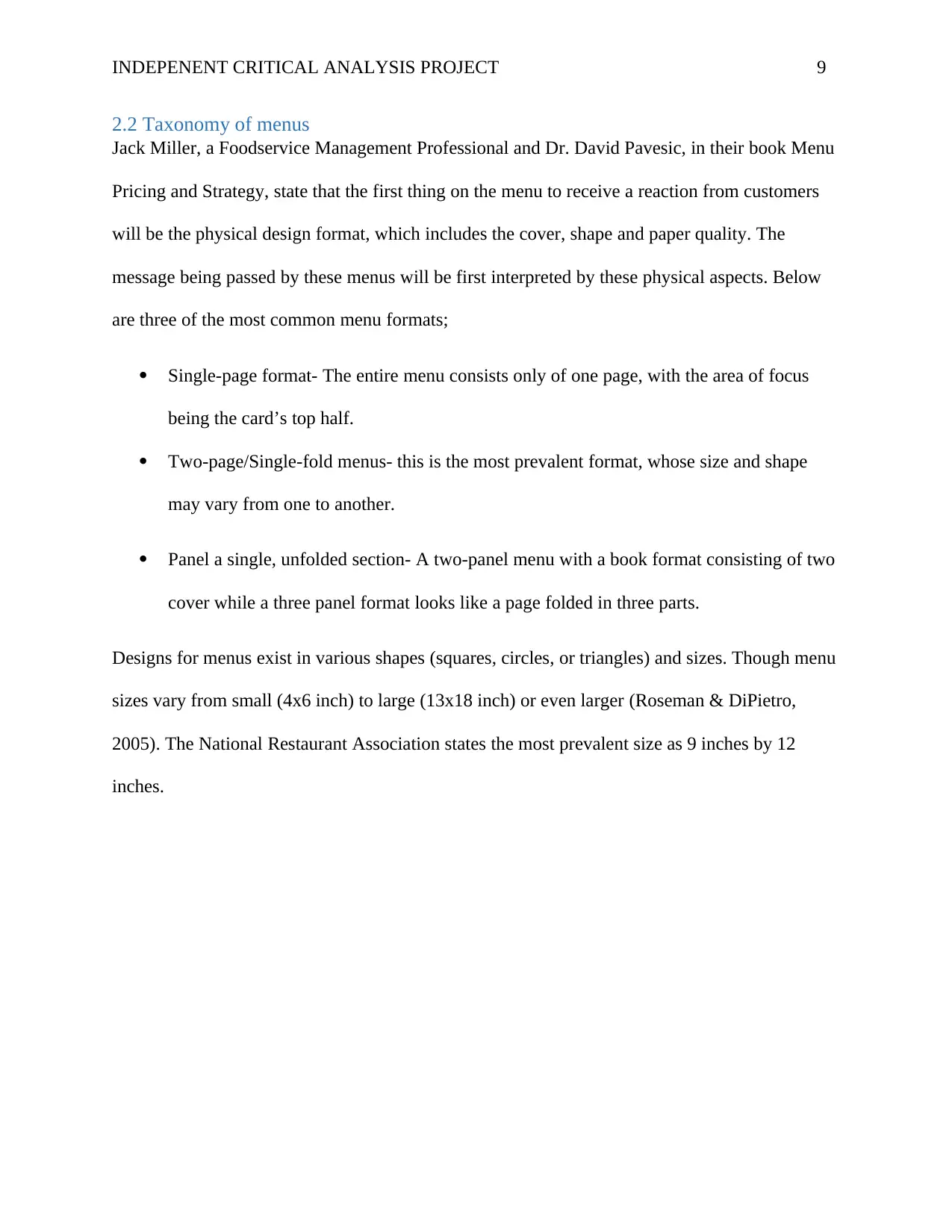
INDEPENENT CRITICAL ANALYSIS PROJECT 9
2.2 Taxonomy of menus
Jack Miller, a Foodservice Management Professional and Dr. David Pavesic, in their book Menu
Pricing and Strategy, state that the first thing on the menu to receive a reaction from customers
will be the physical design format, which includes the cover, shape and paper quality. The
message being passed by these menus will be first interpreted by these physical aspects. Below
are three of the most common menu formats;
Single-page format- The entire menu consists only of one page, with the area of focus
being the card’s top half.
Two-page/Single-fold menus- this is the most prevalent format, whose size and shape
may vary from one to another.
Panel a single, unfolded section- A two-panel menu with a book format consisting of two
cover while a three panel format looks like a page folded in three parts.
Designs for menus exist in various shapes (squares, circles, or triangles) and sizes. Though menu
sizes vary from small (4x6 inch) to large (13x18 inch) or even larger (Roseman & DiPietro,
2005). The National Restaurant Association states the most prevalent size as 9 inches by 12
inches.
2.2 Taxonomy of menus
Jack Miller, a Foodservice Management Professional and Dr. David Pavesic, in their book Menu
Pricing and Strategy, state that the first thing on the menu to receive a reaction from customers
will be the physical design format, which includes the cover, shape and paper quality. The
message being passed by these menus will be first interpreted by these physical aspects. Below
are three of the most common menu formats;
Single-page format- The entire menu consists only of one page, with the area of focus
being the card’s top half.
Two-page/Single-fold menus- this is the most prevalent format, whose size and shape
may vary from one to another.
Panel a single, unfolded section- A two-panel menu with a book format consisting of two
cover while a three panel format looks like a page folded in three parts.
Designs for menus exist in various shapes (squares, circles, or triangles) and sizes. Though menu
sizes vary from small (4x6 inch) to large (13x18 inch) or even larger (Roseman & DiPietro,
2005). The National Restaurant Association states the most prevalent size as 9 inches by 12
inches.
⊘ This is a preview!⊘
Do you want full access?
Subscribe today to unlock all pages.

Trusted by 1+ million students worldwide
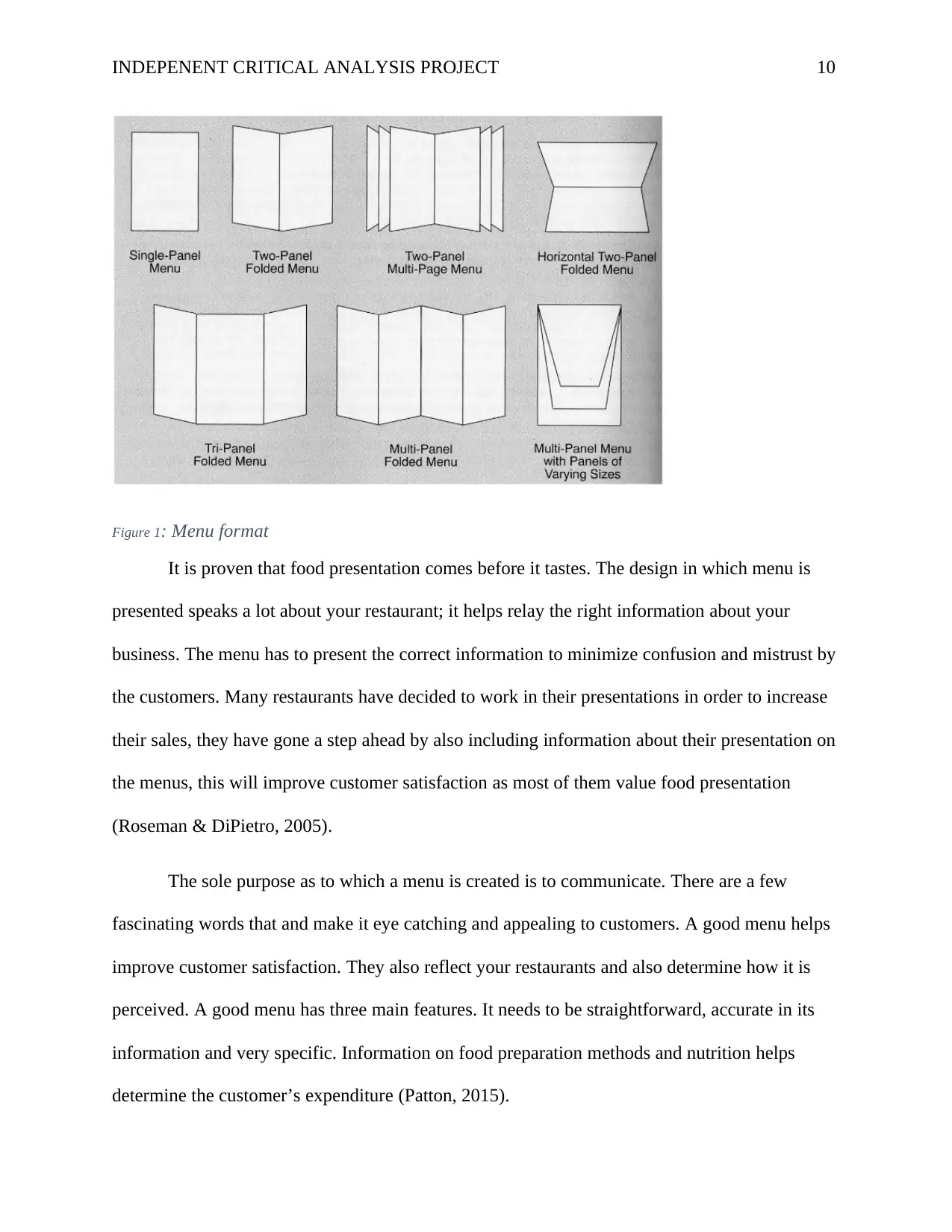
INDEPENENT CRITICAL ANALYSIS PROJECT 10
Figure 1: Menu format
It is proven that food presentation comes before it tastes. The design in which menu is
presented speaks a lot about your restaurant; it helps relay the right information about your
business. The menu has to present the correct information to minimize confusion and mistrust by
the customers. Many restaurants have decided to work in their presentations in order to increase
their sales, they have gone a step ahead by also including information about their presentation on
the menus, this will improve customer satisfaction as most of them value food presentation
(Roseman & DiPietro, 2005).
The sole purpose as to which a menu is created is to communicate. There are a few
fascinating words that and make it eye catching and appealing to customers. A good menu helps
improve customer satisfaction. They also reflect your restaurants and also determine how it is
perceived. A good menu has three main features. It needs to be straightforward, accurate in its
information and very specific. Information on food preparation methods and nutrition helps
determine the customer’s expenditure (Patton, 2015).
Figure 1: Menu format
It is proven that food presentation comes before it tastes. The design in which menu is
presented speaks a lot about your restaurant; it helps relay the right information about your
business. The menu has to present the correct information to minimize confusion and mistrust by
the customers. Many restaurants have decided to work in their presentations in order to increase
their sales, they have gone a step ahead by also including information about their presentation on
the menus, this will improve customer satisfaction as most of them value food presentation
(Roseman & DiPietro, 2005).
The sole purpose as to which a menu is created is to communicate. There are a few
fascinating words that and make it eye catching and appealing to customers. A good menu helps
improve customer satisfaction. They also reflect your restaurants and also determine how it is
perceived. A good menu has three main features. It needs to be straightforward, accurate in its
information and very specific. Information on food preparation methods and nutrition helps
determine the customer’s expenditure (Patton, 2015).
Paraphrase This Document
Need a fresh take? Get an instant paraphrase of this document with our AI Paraphraser
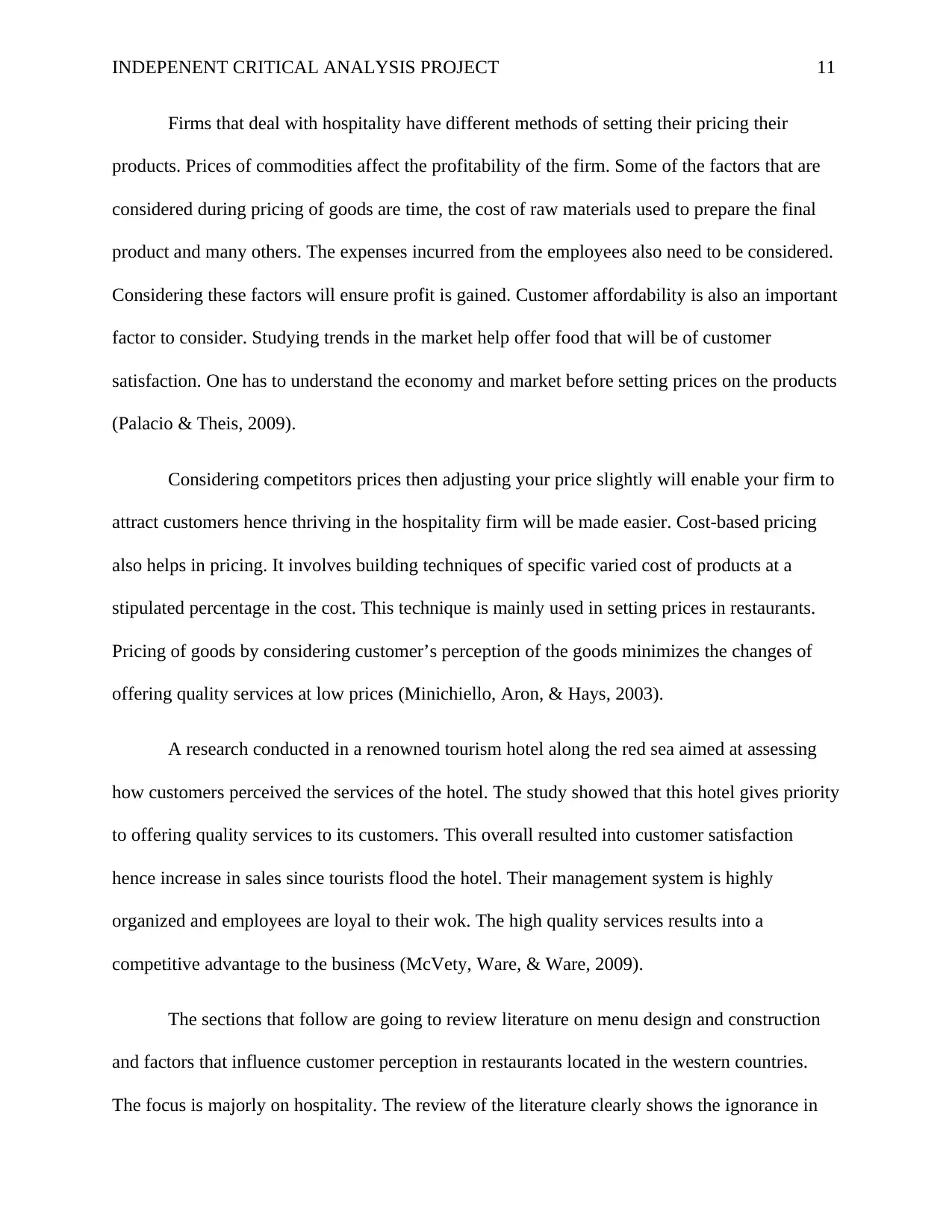
INDEPENENT CRITICAL ANALYSIS PROJECT 11
Firms that deal with hospitality have different methods of setting their pricing their
products. Prices of commodities affect the profitability of the firm. Some of the factors that are
considered during pricing of goods are time, the cost of raw materials used to prepare the final
product and many others. The expenses incurred from the employees also need to be considered.
Considering these factors will ensure profit is gained. Customer affordability is also an important
factor to consider. Studying trends in the market help offer food that will be of customer
satisfaction. One has to understand the economy and market before setting prices on the products
(Palacio & Theis, 2009).
Considering competitors prices then adjusting your price slightly will enable your firm to
attract customers hence thriving in the hospitality firm will be made easier. Cost-based pricing
also helps in pricing. It involves building techniques of specific varied cost of products at a
stipulated percentage in the cost. This technique is mainly used in setting prices in restaurants.
Pricing of goods by considering customer’s perception of the goods minimizes the changes of
offering quality services at low prices (Minichiello, Aron, & Hays, 2003).
A research conducted in a renowned tourism hotel along the red sea aimed at assessing
how customers perceived the services of the hotel. The study showed that this hotel gives priority
to offering quality services to its customers. This overall resulted into customer satisfaction
hence increase in sales since tourists flood the hotel. Their management system is highly
organized and employees are loyal to their wok. The high quality services results into a
competitive advantage to the business (McVety, Ware, & Ware, 2009).
The sections that follow are going to review literature on menu design and construction
and factors that influence customer perception in restaurants located in the western countries.
The focus is majorly on hospitality. The review of the literature clearly shows the ignorance in
Firms that deal with hospitality have different methods of setting their pricing their
products. Prices of commodities affect the profitability of the firm. Some of the factors that are
considered during pricing of goods are time, the cost of raw materials used to prepare the final
product and many others. The expenses incurred from the employees also need to be considered.
Considering these factors will ensure profit is gained. Customer affordability is also an important
factor to consider. Studying trends in the market help offer food that will be of customer
satisfaction. One has to understand the economy and market before setting prices on the products
(Palacio & Theis, 2009).
Considering competitors prices then adjusting your price slightly will enable your firm to
attract customers hence thriving in the hospitality firm will be made easier. Cost-based pricing
also helps in pricing. It involves building techniques of specific varied cost of products at a
stipulated percentage in the cost. This technique is mainly used in setting prices in restaurants.
Pricing of goods by considering customer’s perception of the goods minimizes the changes of
offering quality services at low prices (Minichiello, Aron, & Hays, 2003).
A research conducted in a renowned tourism hotel along the red sea aimed at assessing
how customers perceived the services of the hotel. The study showed that this hotel gives priority
to offering quality services to its customers. This overall resulted into customer satisfaction
hence increase in sales since tourists flood the hotel. Their management system is highly
organized and employees are loyal to their wok. The high quality services results into a
competitive advantage to the business (McVety, Ware, & Ware, 2009).
The sections that follow are going to review literature on menu design and construction
and factors that influence customer perception in restaurants located in the western countries.
The focus is majorly on hospitality. The review of the literature clearly shows the ignorance in
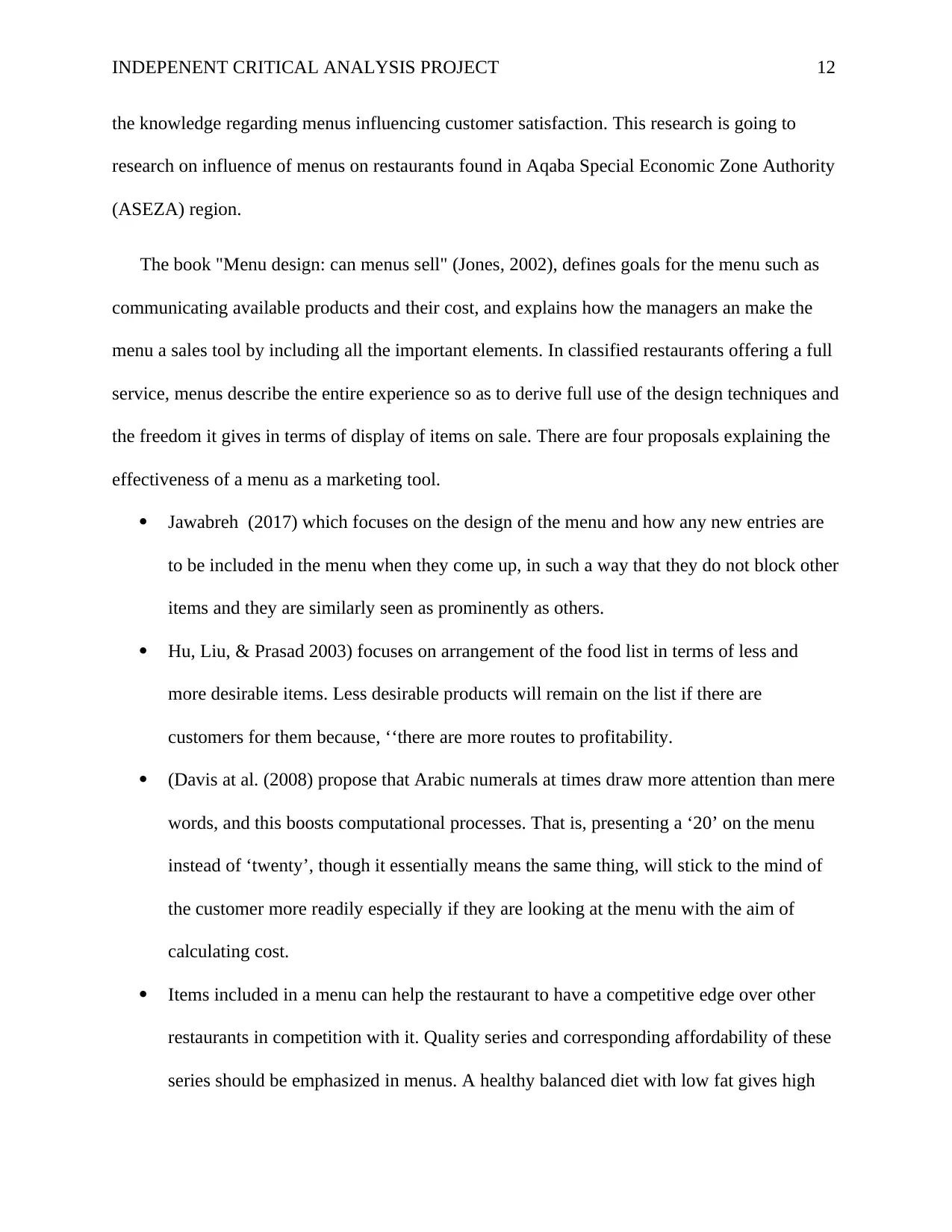
INDEPENENT CRITICAL ANALYSIS PROJECT 12
the knowledge regarding menus influencing customer satisfaction. This research is going to
research on influence of menus on restaurants found in Aqaba Special Economic Zone Authority
(ASEZA) region.
The book "Menu design: can menus sell" (Jones, 2002), defines goals for the menu such as
communicating available products and their cost, and explains how the managers an make the
menu a sales tool by including all the important elements. In classified restaurants offering a full
service, menus describe the entire experience so as to derive full use of the design techniques and
the freedom it gives in terms of display of items on sale. There are four proposals explaining the
effectiveness of a menu as a marketing tool.
Jawabreh (2017) which focuses on the design of the menu and how any new entries are
to be included in the menu when they come up, in such a way that they do not block other
items and they are similarly seen as prominently as others.
Hu, Liu, & Prasad 2003) focuses on arrangement of the food list in terms of less and
more desirable items. Less desirable products will remain on the list if there are
customers for them because, ‘‘there are more routes to profitability.
(Davis at al. (2008) propose that Arabic numerals at times draw more attention than mere
words, and this boosts computational processes. That is, presenting a ‘20’ on the menu
instead of ‘twenty’, though it essentially means the same thing, will stick to the mind of
the customer more readily especially if they are looking at the menu with the aim of
calculating cost.
Items included in a menu can help the restaurant to have a competitive edge over other
restaurants in competition with it. Quality series and corresponding affordability of these
series should be emphasized in menus. A healthy balanced diet with low fat gives high
the knowledge regarding menus influencing customer satisfaction. This research is going to
research on influence of menus on restaurants found in Aqaba Special Economic Zone Authority
(ASEZA) region.
The book "Menu design: can menus sell" (Jones, 2002), defines goals for the menu such as
communicating available products and their cost, and explains how the managers an make the
menu a sales tool by including all the important elements. In classified restaurants offering a full
service, menus describe the entire experience so as to derive full use of the design techniques and
the freedom it gives in terms of display of items on sale. There are four proposals explaining the
effectiveness of a menu as a marketing tool.
Jawabreh (2017) which focuses on the design of the menu and how any new entries are
to be included in the menu when they come up, in such a way that they do not block other
items and they are similarly seen as prominently as others.
Hu, Liu, & Prasad 2003) focuses on arrangement of the food list in terms of less and
more desirable items. Less desirable products will remain on the list if there are
customers for them because, ‘‘there are more routes to profitability.
(Davis at al. (2008) propose that Arabic numerals at times draw more attention than mere
words, and this boosts computational processes. That is, presenting a ‘20’ on the menu
instead of ‘twenty’, though it essentially means the same thing, will stick to the mind of
the customer more readily especially if they are looking at the menu with the aim of
calculating cost.
Items included in a menu can help the restaurant to have a competitive edge over other
restaurants in competition with it. Quality series and corresponding affordability of these
series should be emphasized in menus. A healthy balanced diet with low fat gives high
⊘ This is a preview!⊘
Do you want full access?
Subscribe today to unlock all pages.

Trusted by 1+ million students worldwide
1 out of 24
Related Documents
Your All-in-One AI-Powered Toolkit for Academic Success.
+13062052269
info@desklib.com
Available 24*7 on WhatsApp / Email
![[object Object]](/_next/static/media/star-bottom.7253800d.svg)
Unlock your academic potential
Copyright © 2020–2025 A2Z Services. All Rights Reserved. Developed and managed by ZUCOL.





